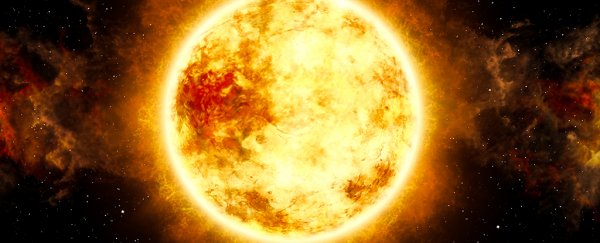Next time you're feeling down, you beautiful thing, just remember – you're made of stardust. Of course, so are faecal bacteria. And serial killers. Not to mention the food you hate eating, rust, arsenic… but even so, it's amazing to think that the materials in our cells once came from somewhere in the sky.
But where exactly? New research has uncovered patches of gas and dust where isotopes of some elements are more common than they should be, challenging what we know about their origins.
Based on the makeup of the relatively young planetary nebula K4-47, researchers from the University of Arizona have proposed another method for the creation of atoms once assumed to have rather exotic origins.
Most of the elements responsible for the complex chemistry behind life and geology are the product of various stellar reactions.
Collect enough hydrogen in one place, and gravity will inevitably start to squeeze it into helium. In turn, helium is pushed together into slightly bigger elements, such as lithium.
To get ever bigger elements to stick together – such as carbon and oxygen – you're going to need some impressive amounts of force, the kind found in the cores of massive stars at least eight solar masses at birth.
Even then, some isotopes of these chunky building blocks are harder to build than others, though. Carbon 13, oxygen 17, and nitrogen 15, for example, have an extra neutron pushed into their nucleus.
It might not seem like much of a difference, but this innocent addition requires an extraordinary amount of grunt. The kind you'd only find in the violent end of a star as it collapses in on itself in an explosive supernova.
Or so scientists figured. But it turns out that there's one niggling problem with this assumption.
"The models invoking only novae and supernovae could never account for the amounts of N-15 and O-17 we observe in meteorite samples," said senior researcher of the study, Lucy Ziurys.
With an overabundance of such heavy isotopes dusting the rocks that fall to Earth, scientists have started to consider other explanations for the elements' creation that don't require such rare astrophysical events.
That's where K4-47 comes in. This cloud of gas and dust 15,000 light years distant is rich in carbon-bearing molecules, many of which are of the extra neutron variety.
"The fact that we're finding these isotopes in K4-47 tells us that we don't need strange exotic stars to explain their origin," says Ziurys.
"It turns out your average garden variety stars are capable of producing them as well."
Stars such as our own Sun don't end their days in a cataclysmic slam of hot, dense gas.
In fact, like 90 percent of all stars, our Sun will gradually expand as it loses mass, its heat quietly puffing its atmosphere out into a red, giant ball. The hot shell of gas then slowly drifts away over time to leave a bright 'white dwarf' core.
It might seem quiet, but one part of the dying process inside these rather common stars should be powerful enough to shove an extra neutron into heavy atoms before letting it drift off into the cosmos.
As gravity loses its grip on the star's lighter outer atmosphere, helium continues to rain down on the core's surface, raising its density and temperature. It takes millions of years to accumulate. But in a virtual snap of the fingers, a trigger-point is eventually reached.
Temperatures hit a crucial point close to 100 million degrees, allowing triplets of helium to form single atoms of carbon, shedding an insane amount of energy in the process.
Far from acting like a gas, this electron deficient helium clings together like an ocean of liquid, trapping the rising heat. The result is what's known as a helium-shell flash.
"A helium flash doesn't rip the star apart like a supernova does. It's more like a stellar eruption," says Ziurys.
In the end, about 6 percent of the helium is converted to plain old carbon. For this supernova-lite to make isotopes like C-13, however, the atoms need to also escape relatively quickly in order to cool down and not be forced to undergo other reactions.
The numbers seem to add up, but more examples would help reinforce the model.
The prevalence of these isotopes in K4-47 could also be explained if it was the result of a binary star system that shared an envelope of gas. One star of sufficient size could produce carbon before they merged, with a collision producing the nebula.
A similar nebula called CK Vul is thought to be the result of such a binary white dwarf merger. It also has the same recipe of carbon and carbon isotopes.
Tracing the origins of particular isotopes back to helium-shell flashes could provide astronomers with a new way of interpreting the history of materials in our own Solar System.
"You can think of the grains we find in meteorites as stellar ashes, left behind by stars that had long died when our Solar System formed," says Ziurys's co-author, Tom Zega.
"We expect to find those pre-solar grains on Bennu – they are part of the puzzle of the history of this asteroid, and this research will help define where the material on Bennu came from."
It might be as rare as we once thought. But it doesn't mean isotopes like carbon-13 any less special.
Maybe there's a lesson in there for all of us.
This research was published in Nature.
